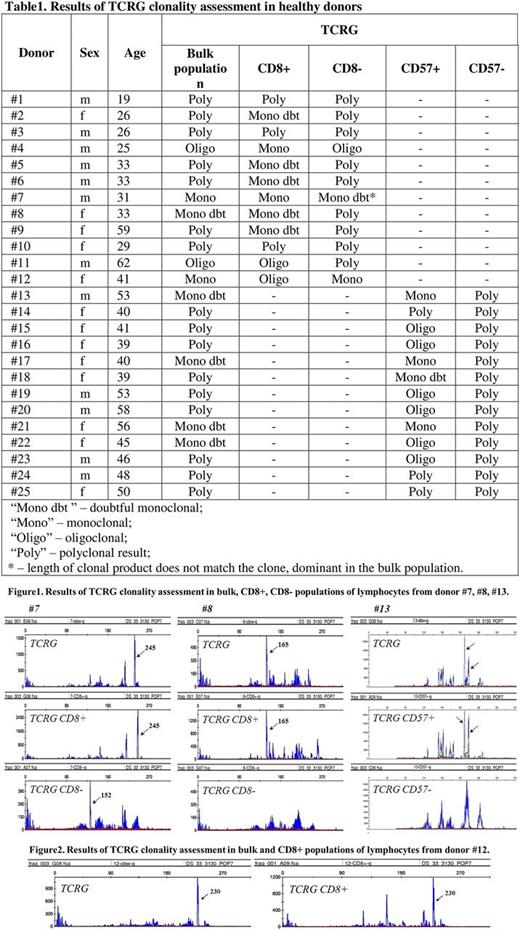Abstract
Introduction
T-cell clonality analysis based on T-cell receptor gamma chain (TCRG) genes rearrangements in peripheral blood could be useful for T-cell neoplasms diagnosis. Monoclonal products that exceed polyclonal background more than 3 times are often seen in lymphoid malignancies. Doubtful clonal results might be a possible feature of a relatively low tumor burden as well as a sign of a benign reactive process or reduction of the repertoire of lymphocytes associated with age. T-cell clonality in peripheral blood has been described in autoimmune diseases and viral infections. Examination of T-cell clonality in healthy people is necessary to define normal values of clonal variation and to develop algorithms for differential diagnosis of reactive and neoplastic conditions. Cytotoxic T-lymphocytes are the intended substrate of reactive processes. CD8 and CD57 are the characteristic surface markers of the cell population. Selection of CD8+ and CD57+ cells followed by determination of clonality based on TCRG genes rearrangements used to correlate clonal products with a specific functional population of lymphocytes and thereby to understand the basis of clonal expansion.
Thus the aim of the research was to study the frequency of T-cell clonality and possible features of the clonal expansion of T-lymphocytes in healthy adults.
Materials and methods
The study included 25 healthy donors with a median age of 40 years (from 19 to 62 years). Samples of peripheral blood were obtained at the blood transfusion facility of the National Research Center for Hematology. All donors gave informed consent for participation in the research.
CD8+ and CD57+ lymphocytes were isolated by means of immunomagnetic selection on Miltenyi Biotec beads. T-cell clonality was assessed by TCRG gene rearrangements using multiplex PCR with BIOMED-2 primer system and subsequent GeneScan analysis.
Results
Bulk lymphocyte population in 2 of 25 donors (8%) was monoclonal, in 5 (20%) donors -doubtful monoclonal, in 2 donors (8%) - oligoclonal and in 16 of 25 donors (64%) - polyclonal (table 1). Thus there was the predominance of reactive clonal populations in the bulk population of cells in 28% (7/25) of donors.
No correlation of the presence of clonal products with the age of donors has been demonstrated (Spearman test). According to the literature the frequency of clonal expansion of lymphocytes increases after 60 years. On the contrary, all participants in our study with the sole exception were younger. The median age of donors was 40 years. We suggest than at least in our donor sample T-cell clonality might be associated with individual characteristics of the donors rather than age related T-cell repertoire narrowing.
Clonal products dominant in bulk population of lymphocytes, were attributed to CD8+ and CD57+ cells by means of magnetic selection. Therefore, the association of reactive clonal products with cytotoxic lymphocytes (figure 1, #8, #13) might be assumed.
Additionally, in the case of donor #7 doubtful clonal product was discovered in the CD8- population, not previously dominant in the bulk population of lymphocytes and not identified in the CD8+ population (figure 1, #7).
Since clear monoclonality of donor case #12 (figure 2) additional blood tests were run. No deviations in blood formula were found. Clinical evaluation confirmed the woman to be healthy, without any symptoms or history of chronic viral or autoimmune diseases.
Conclusions
The presence of clonal expansion of T-lymphocytes in peripheral blood should not be taken as a specific feature of lymphoid malignancy when seen in the absence of clinical or pathological signs of the disease. The typical cause of such conditions is the accumulation of clonal cytotoxic CD8+ CD57+ cells. The nature of clonal products in CD8- populations of lymphocytes are currently not clear and requires more extensive investigation.
No relevant conflicts of interest to declare.
Author notes
Asterisk with author names denotes non-ASH members.


This feature is available to Subscribers Only
Sign In or Create an Account Close Modal